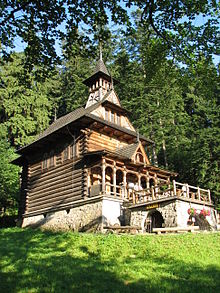Zakopane style

The Zakopane style (or Witkiewicz style) is a direction of architecture inspired by the regional architecture of the Polish highland region near Zakopane . The region known as Podhale on the northern edge of the Tatra Mountains developed its own wooden architecture, which was mainly founded by the Gorals living there . Stanisław Witkiewicz , who was born in the Lithuanian village of Pašiaušė, was inspired by the existing traditions and developed the Zakopane style from them in the Art Nouveau era . The houses designed by Witkiewicz from the 1890s onwards combined traditional regional timber architecture with elements of the then modern architecture. There is a parallel to the almost simultaneous Heimat style of the Alpine countries. An important example of such a building is the Villa Koliba .
- Villa Koliba
Villa Koliba at Ulica Kościeliska 18 was built from 1892 to 1893 as the first Zakopane-style building according to a design by Stanisław Witkiewicz. The name "Koliba" comes from the local dialect and means shepherd's hut. In 1993 the villa became the seat of the Zakopane Style Museum. The interior of Władysław Hasior can also be admired in the building.
Further representatives of this architectural direction were: W. Matlakowski, W. Elias-Radzikowski and J. Wojciechowski .
Realized buildings
- Villa Koliba
- Villa Atma
- Villa Pod Jedlami
- Villa Konstantynówka
- Villa Oksza
Web links
- Zakopane Style Museum
- The wooden architecture route of Małopolska Organizacja Turystyczna




